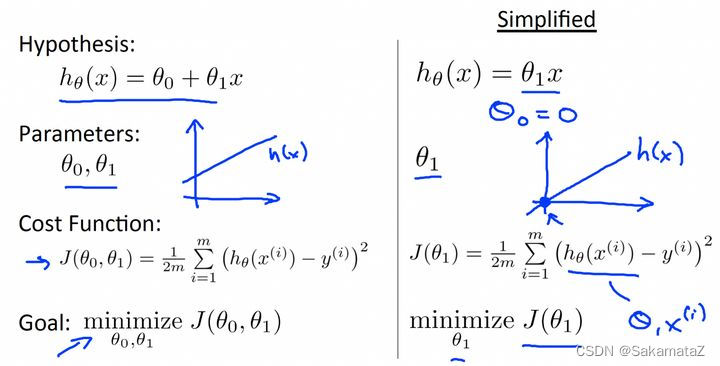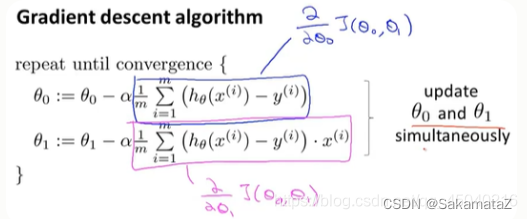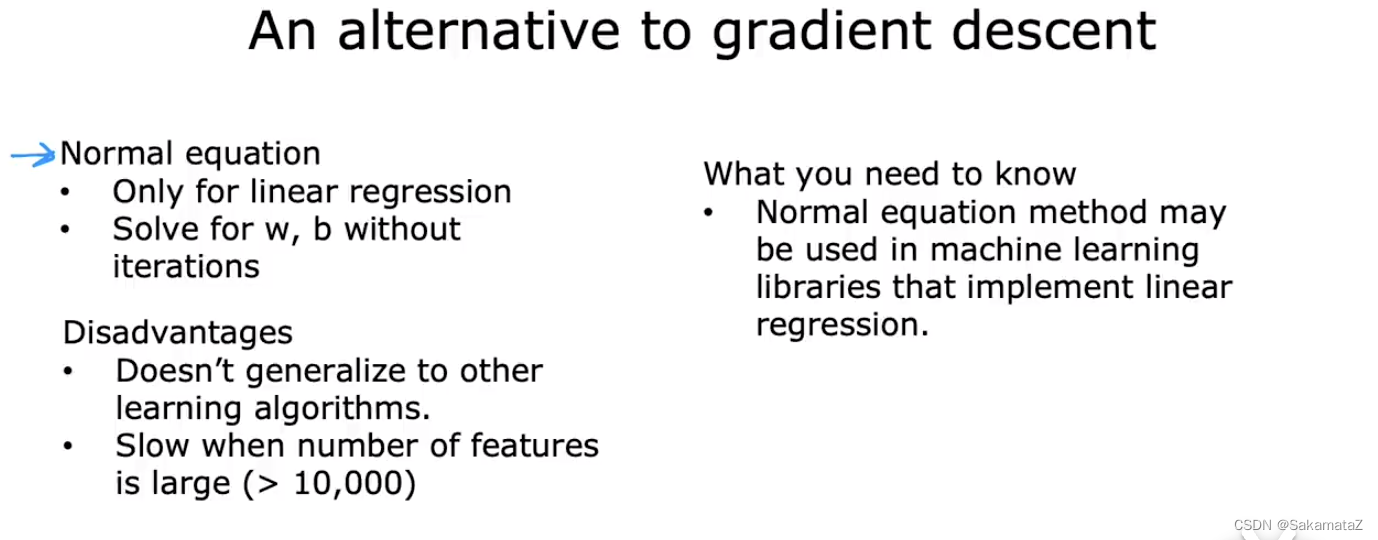吴恩达机器学习课后作业。因为这学期内容不全,所以用的往年的题目。还未施工完成
第一章介绍了一下机器学习,监督学习,无监督学习,回归算法。
线性回归是一种有监督的学习,解决的是自变量和因变量之间的关系。
单变量线性回归就是从一个输入值预测一个输出值;而多变量线性回归就是从多个输入值预测一个输出值。
实验的目的在于学习单变量的线性回归和多变量线性回归算法,总之,以后看到线性的输入输出值关系,都可以带到下面的算法里面跑一下看看
单变量线性回归
第一步:实现代价函数
代价函数就是右边这个东东,

在线性回归中,我们假设数据呈线性分布,代价函数用于进行参数选择(即拟合),最常用的是最小均方误差函数

def computeCost(X,y,theta):
m=len(X)
part=np.power((X*theta.T-y),2)
return sum(part)/(2*m)
第二步:实现线性回归中的梯度下降函数

# theta是为0的初始矩阵,alpha是下降率,iters是梯度下降循环次数
def gradientDescent(X,y,theta,alpha,iters):
temp=np.matrix(np.zeros(theta.shape))
parameters=int(theta.ravel().shape[1])
cost=np.zeros(iters)
for i in range(iters):
error = (X*theta.T) - y
for j in range(parameters):
term=np.multiply(error,X[:,j])
temp[0,j]=theta[0,j]-((alpha/len(X))*np.sum(term))
theta=temp
cost[i]=computeCost(X,y,theta)
return theta,cost
最后绘制线性模型,观察拟合程度。
完整代码如下:
import numpy as np
import pandas as pd
import matplotlib.pyplot as plt
def computeCost(X,y,theta):
m = len(X)
inner = np.power(X*theta.T-y,2)
return np.sum(inner)/(2*m)
def gradientDescent(X,y,theta,alpha,iters):
temp = np.matrix(np.zeros(theta.shape))
parameters = int(theta.shape[1])
cost=np.zeros(iters)
for i in range(iters):
error = X*theta.T - y
for j in range(parameters):
term=np.multiply(error,X[:,j])
temp[0,j]=temp[0,j] - (alpha*np.sum(term)/(len(X)))
theta=temp
cost[i]=computeCost(X,y,theta)
return cost,theta
alpha = 0.01
iters = 1500
path = 'ex1data1.txt'
data = pd.read_csv(path,header=None,names=['Population','Profit'])
data.plot(kind='scatter',x='Population',y='Profit',figsize=(12,8))
plt.show()
data.insert(0,'Ones',1,False)
cols = data.shape[1]
X = data.iloc[:,:-1]
y = data.iloc[:,cols-1:cols]
X = np.matrix(X)
y = np.matrix(y)
theta = np.matrix(np.array([0,0]))
cost,theta=gradientDescent(X,y,theta,alpha,iters)
print(cost)
print(theta)
predict1=[1,3.5]*theta.T
predict2=[1,7]*theta.T
print(predict1)
print(predict2)
x = np.linspace(data.Population.min(),data.Population.max(),100)
f = theta[0,0] + (theta[0,1] * x)
fig,ax=plt.subplots(figsize=(12,8))
ax.plot(x,f,'r',label='Prediction')
ax.scatter(data.Population, data.Profit, label='Traning Data')
ax.legend(loc=2)
ax.set_xlabel('Population')
ax.set_ylabel('Profit')
ax.set_title('Predicted Profit vs. Population Size')
plt.show()
多变量线性回归
向量化和正规方程解决了多变量线性回归的问题

首先进行特征归一化:
特征归一化的目的是为了缩短梯度下降收敛的时间,提高速度。
特征归一化有两种常用的手段:1)最大最小规范化 2)Z-score均值规范化(如下图)

其次使用梯度下降法:
# 加一列常数项
data2.insert(0, 'Ones', 1)
# 初始化X和y
cols = data2.shape[1]
X2 = data2.iloc[:,0:cols-1]
y2 = data2.iloc[:,cols-1:cols]
# 转换成matrix格式,初始化theta
X2 = np.matrix(X2.values)
y2 = np.matrix(y2.values)
theta2 = np.matrix(np.array([0,0,0]))
# 运行梯度下降算法
g2, cost2 = gradientDescent(X2, y2, theta2, alpha, iters)
g2
正规方程方法:
正规方程和梯度下降的区别,梯度下降需要迭代、耗费系统资源较多、需要选择学习率、适用性良好;正规方程法无需选择学习率、无需迭代计算、n很大的时候计算缓慢
def normalEqn(X,y):
# A=np.linalg.inv(X.T*X)
# theta=A*X.T*y
theta = np.linalg.inv(X.T@X)@X.T@y#X.T@X等价于X.T.dot(X)
return theta
final_theta2 = normalEqn(X,y)
print(final_theta2)